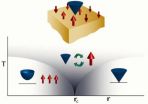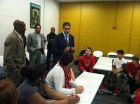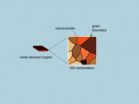(Press-News.org) According to a clinical trial led by University of Cincinnati researchers, a snack food ingredient called olestra has been found to speed up the removal of toxins in the body.
Results are reported in the April edition of the Journal of Nutritional Biochemistry.
The trial demonstrated that olestra—a zero-calorie fat substitute found in low-calorie snack foods such as Pringles—could reduce the levels of serum polychlorinated biphenyls (PCBs) in people who had been exposed to PCBs.
High levels of PCBs in the body are associated with an increase in hypertension and diabetes.
"The findings showed that the rate of PCB disappearance from the participants that ate olestra was markedly faster during the one-year trial than that before the trial," says principal investigator Ronald Jandacek, PhD, an adjunct professor in the department of pathology and laboratory medicine at UC's College of Medicine.
Olestra (brand name Olean) is a nonabsorbable fat product that Procter & Gamble developed in collaboration with UC and was introduced in snack foods (most notably Pringles) in 1996. Early reports of indigestion issues, however, prompted reformulation of the product prior to its market entry. The Kellogg Company purchased the Pringles brand in 2012.
"Olestra is a fat that passes through the body and remarkably it has revealed a potential health benefit of removing PCBs. Our early work with animal studies predicted that we would see this effect in people," Jandacek says of the clinical trial.
Twenty-eight residents Anniston, Ala., who had known high levels of PCBs participated in the yearlong study. Half of the participants consumed 12 Pringles a day made with vegetable oil, and the other half consumed 24 Pringles a day made with olestra. The serving sizes varied to control for calorie count.
According to the results, the half who ate the olestra chips had a PCB rate of decrease of 8 percent, an eight-fold increase in the rate of removal prior to the study compared with those who ate the chips with vegetable oil, who had a 1 percent increase in the rate of removal.
"Olestra's effect on PCB removal is apparently the result of solubilizing fat-soluble compounds like PCBs in the intestine and the solubilization reduces absorption of these compounds into the body," says Jandacek, who was the principal investigator on a 2005 study that found that olestra removed toxins from animals.
Jandacek was first introduced to researchers and community advocates studying the health of residents in Anniston in 2008. The Alabama town was once the main production site for a factory that made PCBs. Since Jandacek had already facilitated the use of olestra in the removal of PCBs from animals and a patient in Australia, he joined with the clinical research group of James Heubi, MD, of Cincinnati Children's Hospital Medical Center, UC's Department of Pediatrics and the UC Center for Clinical and Translational Science and Training; researchers at the Centers for Disease Control and Prevention; and nearby Jacksonville State University College of Nursing to pursue the human trial.
INFORMATION:
The trial was supported by the National Institute of Environmental Health Sciences and the National Center for Research Resources and the National Center for Advancing Translational Sciences, all of the National Institutes of Health.
UC-led research finds chips with olestra cause body toxins to dip
2014-04-09
ELSE PRESS RELEASES FROM THIS DATE:
Gusev Crater once held a lake after all, says ASU Mars scientist
2014-04-09
TEMPE, Ariz. - If desert mirages occur on Mars, "Lake Gusev" belongs among them. This come-and-go body of ancient water has come and gone more than once, at least in the eyes of Mars scientists.
Now, however, it's finally shifting into sharper focus, thanks to a new analysis of old data by a team led by Steve Ruff, associate research professor at Arizona State University's Mars Space Flight Facility in the School of Earth and Space Exploration. The team's report was just published in the April 2014 issue of the journal Geology.
The story begins in early 2004, when NASA ...
One kind of supersymmetry shown to emerge naturally
2014-04-09
UC Santa Barbara physicist Tarun Grover has provided definitive mathematical evidence for supersymmetry in a condensed matter system. Sought after in the realm of subatomic particles by physicists for several decades, supersymmetry describes a unique relationship between particles.
"As yet, no one has found supersymmetry in our universe, including at the Large Hadron Collider (LHC)," said the associate specialist at UCSB's Kavli Institute for Theoretical Physics (KITP). He is referring to the underground laboratory in Switzerland where the famous Higgs boson was identified ...
Violence intervention program effective in Vanderbilt pilot study
2014-04-09
Violent behavior and beliefs among middle school students can be reduced through the implementation of a targeted violence intervention program, according to a Vanderbilt study released in the Journal of Injury and Violence Research.
Manny Sethi, M.D., assistant professor of Orthopaedic Surgery and Rehabilitation, and his Vanderbilt co-authors evaluated 27 programs nationwide as part of a search for an appropriate school-based violence prevention program.
Their findings led to a single, evidence-based conflict resolution program that was evaluated in a pilot study of ...
Stanford scientists discover a novel way to make ethanol without corn or other plants
2014-04-09
Stanford University scientists have found a new, highly efficient way to produce liquid ethanol from carbon monoxide gas. This promising discovery could provide an eco-friendly alternative to conventional ethanol production from corn and other crops, say the scientists. Their results are published in the April 9 advanced online edition of the journal Nature.
"We have discovered the first metal catalyst that can produce appreciable amounts of ethanol from carbon monoxide at room temperature and pressure – a notoriously difficult electrochemical reaction," said Matthew ...
Novel approach to accelerate metabolism could lead to new obesity treatment
2014-04-09
BOSTON – By manipulating a biochemical process that underlies cells' energy-burning abilities, investigators at Beth Israel Deaconess Medical Center (BIDMC) have made a novel discovery that could lead to a new therapy to combat obesity and diabetes.
Published in the April 10 issue of the journal Nature, the new findings show that reducing the amount of nicotinamide N-methyltransferase (NNMT) protein in fat and liver dramatically reduces the development of obesity and diabetes in mice.
'With this discovery, we now have a means of metabolic manipulation that could ...
A bad penny: Cancer's thirst for copper can be targeted
2014-04-09
DURHAM, N.C. – Drugs used to block copper absorption for a rare genetic condition may find an additional use as a treatment for certain types of cancer, researchers at Duke Medicine report.
The researchers found that cancers with a mutation in the BRAF gene require copper to promote tumor growth. These tumors include melanoma, the most dangerous form of skin cancer that kills an estimated 10,000 people in the United States a year, according to the National Cancer Institute.
"BRAF-positive cancers like melanoma almost hunger for copper," said Christopher M. Counter, ...
UC San Diego researchers develop bacterial 'FM radio'
2014-04-09
Programming living cells offers the prospect of harnessing sophisticated biological machinery for transformative applications in energy, agriculture, water remediation and medicine. Inspired by engineering, researchers in the emerging field of synthetic biology have designed a tool box of small genetic components that act as intracellular switches, logic gates, counters and oscillators.
But scientists have found it difficult to wire the components together to form larger circuits that can function as "genetic programs." One of the biggest obstacles? Dealing with a small ...
New 'switch' could power quantum computing
2014-04-09
Using a laser to place individual rubidium atoms near the surface of a lattice of light, scientists at MIT and Harvard University have developed a new method for connecting particles — one that could help in the development of powerful quantum computing systems.
The new technique, described in a paper published today in the journal Nature, allows researchers to couple a lone atom of rubidium, a metal, with a single photon, or light particle. This allows both the atom and photon to switch the quantum state of the other particle, providing a mechanism through which quantum-level ...
Synthetic collagen promotes natural clotting
2014-04-09
Synthetic collagen invented at Rice University may help wounds heal by directing the natural clotting of blood.
The material, KOD, mimics natural collagen, a fibrous protein that binds cells together into organs and tissues. It could improve upon commercial sponges or therapies based on naturally derived porcine or bovine-derived collagen now used to aid healing during or after surgery.
The lab of Jeffrey Hartgerink, a chemist and bioengineer based at Rice's BioScience Research Collaborative, developed synthetic collagen several years ago. The lab's analysis of KOD ...
Spike in postoperative cardiac surgery deaths may be linked to 30-day survival measurement
2014-04-09
Analyzing a national database of hospital inpatient records, a team of researchers reports an expected spike in mortality six days after cardiac surgery, but also a more surprising and potentially troubling jump in deaths at the 30-day mark.
In a report on the study, they suggest that while there could be "organic" medical reasons for the extra deaths, the more likely explanation may be an unintended consequence of putting so much emphasis on marking one-month "survival" as a key measurement of surgical success.
"One possibility for the spike is that by often measuring ...



